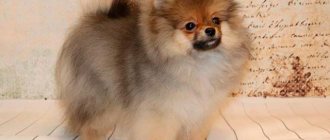The miniature German Spitz is a distant descendant of the wolf. From a strong and strong ancestor, the dwarf dog inherited good health, developed intelligence, an intuitive understanding of emotions and the ability to exist independently. Information about Pomeranians with a unique cream-sable color first appears in the 18th century.
Characteristics of Spitz cream-sable color
The dwarf, or Pomeranian, Spitz is a small decorative breed. Weight from 1.4 to 3.2 kg (preferably 2 kg). Height at the withers is 18-22 cm. The breed is divided into three groups:
- “Fox” (long muzzle, narrow chin, soft cheeks);
- “Teddy Bear” (round muzzle, raised chin, full cheeks);
- “Baby doll” or “toy” (the face is similar to a bear’s, but flatter, the eyes are widely spaced).
With proper care and good heredity, this friendly dog can live 12-16 years. There are centenarians who are 18 years old.
Celebrities
The sable color of the Spitz has its roots in 18th century Germany and has many famous representatives. These include a female Pomeranian with a puppy that belonged to Queen Charlotte and depicted in the painting by Thomas Gainsborough, the pets of Queen Victoria of Great Britain and many others.
Modern representatives of the show, sports and film industries also often prefer sable Spitz. Among the famous sables and their owners, the following should be highlighted:
- Natalya Gulkina and her sable Spitz Fenechka.
- Mickey Rourke and his Oscar.
- Eva Longoria and her pets.
- Anna Semenovich and her Marcy.
The sable color of Spitz dogs can often be found in paintings and cinema.
A photo of a sable Pomeranian Spitz already makes you fall in love with this wonderful breed, not to mention a real perky and cheerful dog.
With proper care, feeding and education, these friendly animals can become not only beautiful toys that attract all the attention of others, but also real best friends, companions in any business or travel! tagscelebrities color sable color
Breed standards
Sable fur has a light tone of varying intensity at the root and an obligatory dark tip. It looks like every strand of hair is covered in black dye. Depending on the color of the part of the hair closest to the root, the sable standard is divided into several groups:
- ginger;
- cream;
- grey;
- orange.
The most common wolf coat color is gray at the root. The standard requires that the Pomeranian Wolf Spitz coat meet the following requirements:
- root tone is silver-gray;
- mandatory black tip;
- the ears and muzzle are a couple of shades darker than the rest of the body;
- lighter shade on the shoulders and mane;
- there is a clear black line from the outer corner of the eye to the lower corner of the ear;
- there are no black marks on the legs below the knee joint;
- the tip of the tail is black, and the inside and “pants” are light.
An important feature of a purebred sable miniature spitz is the complete matching of the color of the muzzle and ears.
The Diana Finch Experience
There is a legendary breeder in America; dogs from her kennel are present in almost all pedigrees of modern Pomeranians. The woman's name is Diana Finch, and she willingly shares her experience in breeding Paticolor Spitz dogs.
What color is this? The main color is white, and symmetrical spots of a different shade are scattered across it. The so-called paticolor color does not exist in the breed standard. But there are several colors that are the basis of what is discussed here:
- Irish is when there are more spots than the main color. These dogs are very similar to Shelties.
- Piebald includes spots on an overall white background.
- Extreme piebald is distinguished by two or three spots, the rest of the color is deep white.
Dog character and behavior
A small German Spitz, sable or any other color, is an intelligent animal with a complex temperament. It can be a fun and playful companion, but without proper training it can turn its owner's life into a nightmare. If an orange considers itself offended, it can organize a whole performance: refusal to eat and communicate, demonstrative departure of the “sufferer,” barking, screaming, whining, persistent hysteria. If the owner has at least once succumbed to the cunning kid’s trick, the pet will repeat the performance all the time.
From the first days of the puppy's appearance, it is necessary to establish a strict hierarchy: the owner is the master, not the orange. This is difficult to do when looking at a funny cream-colored dog with a cute face. But a small weakness will turn into big problems in the future. Raised Orange is suitable for any team, selflessly devoted to its owner, loves to have fun with children, and is ready for new adventures.
Feeding
Like most other miniature breeds, the Spitz, whose black color is not considered very rare, is prone to obesity. Therefore, you need to take a responsible approach to everything related to the food of this dog.
Many professional breeders recommend giving such animals high-quality dry food. It is believed that it contains all vital vitamins and microelements.
Those who decide to feed their pet natural food need to remember that in this case, most of the dog’s diet should consist of meat. It is also important to ensure that the black Spitz regularly receives rice, buckwheat, cottage cheese, kefir and vegetables. As for prohibited foods, these include potatoes, legumes, sausage, confectionery, pasta and chocolate.
Sable coat care
A puppy's first shedding is a nightmare for an untrained dog owner. But this only happens once, as the baby's down changes. It will be easier later. A special diet will help make care and cleaning easier. It has a good effect on the condition of the coat and slightly reduces “losses” during molting of sea fish, fish oil, cereals and special vitamin compounds.
Don't get carried away with water treatments. After a walk, you just need to wash your paws. During shedding, you should not bathe your orange - too much exposure to chemicals causes hair loss. Also, improper cutting can damage the coat. Grooming a Pomeranian Spitz to zero is strictly prohibited. This not only affects the condition of the coat, but can also affect the color.
Bathing in the bath
The bathroom requires special products; “human” shampoos are not suitable. To keep your orange's coat shiny and well-groomed, you need high-quality products for long-haired dogs.
Combing wool
The Spitz needs to be brushed twice a week. You will need a special comb and brush. First, use careful movements (without jerking) to comb the hair in the direction of hair growth. When all the hairs are untangled, it’s the turn of the brush. It is processed in different directions to completely comb through the thick fur. During shedding (in spring), brushing is a daily chore.
A haircut
It is better to entrust the haircut to a specialist. Only the main hair should be carefully trimmed, not the undercoat. Work begins with the hairline at the base of the ears and tail, then on the paws and collar.
Command learning
The Spitz is a fairly smart dog. If you work with her regularly, then the dog is quite capable of mastering basic commands, such as “sit”, “lie down”, “come to me”, “voice”, “near”. You just need to pay attention to your pet and try to reward him with treats in a timely manner. Believe me, it will be very nice to demonstrate to others that your four-legged friend really can do a lot. Not everyone, unfortunately, finds the time to work with a dog and make the appropriate efforts for this.
How does sable color change with age?
The puppy's color changes over time. The fact is that the puppy’s fur, which disappears over time, changes the perception of the color of the coat. Until about two and a half months, puppies look like fluffy gray lumps. Only after changing the coat does the main cream color appear.
The coat color of a Pomeranian Spitz also changes throughout its life. An adult orange or cream sable has a more uniform coloration. Bright colors fade, the ends become lighter and closer in tone to the main dress. If it is a cream sable, when it is “old” it will be completely cream.
Diseases
Let's figure out what diseases are typical for the Pomeranian breed:
- Bone displacements and fractures, joint problems;
- Tartar;
- Problems with the gastrointestinal tract (gastrointestinal tract);
- Excessive tearing;
- Hypoglycemia – low blood sugar;
- Dwarfism (dwarfism);
- Hypothyroidism – insufficiency of the thyroid gland;
- Hydrocephalus (water on the brain).
A reasonable approach to purchasing a puppy and studying information about the breed will help you not to be disappointed in the Pomeranian breed.
Contents in the apartment
The modest size of the Pomeranian allows it to be kept even in a small apartment. Before purchasing “Soft Joy,” you need to prepare not only the place, but the entire room. Small items from the floor, shoes, household chemicals, building materials - move them to a closet with a securely closing door. Remove rugs and carpets until the tray turns orange. Blocks access to cables and hazardous household chemicals. If the puppy is left at home alone, you can arrange a small enclosure for him. This is a reliable way to protect the environment from a playful child and the dog itself from harm.
Of course, there will be difficulties when breeding an orange, but this is true for any breed. And dogs are undemanding in care. They rarely get sick (if there are no hereditary diseases), take care of their fur like cats, and are unpretentious in food. In addition to training, feeding and walking, the owner must regularly comb the orange's long and thick fur.
Should you go to a dog groomer?
A little more about appearance: owners often cut their dogs' hair. In an effort to save on a groomer, they do it themselves. And out of ignorance, they cut the pet’s fur very short. It then grows too slowly, and in some dogs it remains short altogether. If you are planning to pursue an animal's exhibition career, do not skimp on the groomer. He knows all the subtleties and intricacies of the breed's hair, as well as the haircuts necessary for exhibitions.
Prices for sable spitz puppies
The range in cost of children is significant - from 10 to 200 thousand rubles. It is possible to get a German Spitz puppy out of your hands at a reasonable price, but it is difficult to say whether it will actually be orange or cream in color. The fact is that only at the age of 2.5 months do puppies acquire their final color. Theoretically, the future color of a puppy can be determined at an early age by the color of the fur near the anus and behind the ears, but this requires experience and a “trained eye.”
It is safer, although more expensive, to buy sable from a kindergarten. Breeders provide the puppy's pedigree, guarantee color and the absence of hereditary diseases. The highest price is for show-class Spitz dogs. They are suitable for exhibitions and breeding; if desired, the owner will quickly recoup the investment.
Unrecognized colors
Jack Russell Terrier: black, white, brown, tri-color and other colors
Future dog owners need to know that, in accordance with the standard adopted by the Russian Canine Federation, some colors are considered a breed defect. This is due to the fact that such colors are a consequence of crossbreeding (violation of the purity of the breed) and entail the inheritance of certain health problems.
Important! For such dogs the opportunity to participate in exhibitions and breeding is closed. But this does not mean that they cannot be devoted friends, favorites and full members of the family.
The following colors are unrecognized for Spitz:
- chocolate sable;
- chocolate with tan;
- blue-sable;
- brindle;
- blue;
- tricolor;
- blue and tan;
- marble.
The presence of white spots will disqualify a dog if the base color is not white. The nose of a Spitz should be colored to match the coat (for brown dogs, black is allowed). During the winter months, light-colored Spitz dogs often have a lighter color, but this is not a reason for disqualification.
How to distinguish sable color from similar coat colors?
"Sable" can be confused with multicolored hair, in which the hair varies in color but is a uniform color throughout its length. Only a specialist can determine the color of Pomeranian puppies. Small fluffy lumps are covered with a single-colored coat, which over time acquires a final creamy-black color.
Real sable looks amazing. Zoning (the transition from one color to another) should be on each hair. A Pomeranian with such a coat seems to glow from the inside from afar. This effect is best demonstrated in the dwarf sable. The entire orange should be covered with hair in zones, not just in individual areas.
What are the eye colors of Spitz dogs?
Spitz fox (red orange): comparison with a bear cub
An adult Spitz should have dark eyes with black eyelids; brown ones are allowed dark brown.
Most representatives of the breed have dark brown or black eyes. A Spitz of white and red color or another light color may have irises of hazel or amber color.
A small puppy, less than 2 months old, usually has light blue eyes that darken with age. The small amount of pigment in the iris of albinos results in a reddish tint to the eyes. A representative of the merle or merle color, which is not recognized by the standard, is an unusual Spitz with bright blue eyes.
When paying attention to the color of the dog when buying, you need to remember that this is not the main thing. Soon a living creature with its own character and habits will enter the apartment. It will require care and attention, and in return it will give love and devotion.
Living decoration
The Pomeranian breed has come a difficult way from northern sled dogs to favorites of the aristocracy. Sable color is a “living decoration”. And it doesn’t matter which color you like: delicate cream, calm gray or fiery red. Any of the oranges attracts attention and pleases the eye.
The Pomeranian is an intelligent, beautiful and charming dog with a very complex character. This breed is not recommended for beginning breeders. And it's not about the difficulty of care. A creamy and fluffy pet with a cute face is able to conquer the whole family and make everyone revolve around the “royal” person.
Photo
In the photo are representatives of sable Spitz dogs:
Sable color
Cream sable color
Orange sable
Gray sable











